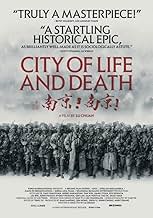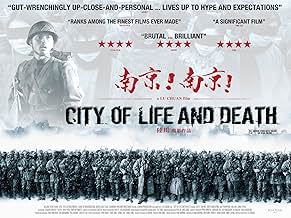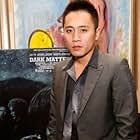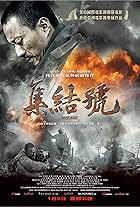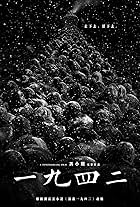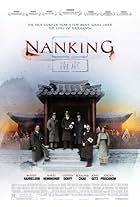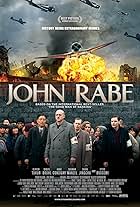In 1937, Japan occupied Nanjing, the Chinese capital. There was a battle and subsequent atrocities against the inhabitants, especially those who took refuge in the International Security Zon... Read allIn 1937, Japan occupied Nanjing, the Chinese capital. There was a battle and subsequent atrocities against the inhabitants, especially those who took refuge in the International Security Zone.In 1937, Japan occupied Nanjing, the Chinese capital. There was a battle and subsequent atrocities against the inhabitants, especially those who took refuge in the International Security Zone.
- Awards
- 17 wins & 15 nominations total
Ryu Kohata
- Officer Osamu Ida
- (as Kohata Ryuichi)
Sam Voutas
- Durdin
- (as You Sima)
- Director
- Writer
- All cast & crew
- Production, box office & more at IMDbPro
Featured reviews
A very fine movie, strong and rather heavy. I was relatively familiar with the events that took place in Nanjing therefore I was not surprised by the atrocities I saw reenacted on the big screen.The device of shooting the film in black and white was effective, in the sense that it created an impression akin to a documentary or a current affairs reportage of the age. Alessandro Ahmenabar may have said that he wanted "Agora" to give the impression that it reported events from 4th century A.D. Alexandria like a CNN live correspondence but I think "The City of Life and Death" was the movie that succeeded on that, giving to the spectator the impression of watching the events in live coverage.
Although it portrayed numerous atrocities, it masterfully avoided the trap of succumbing to "pornography of violence". It also tried to treat the incidences of mass rape and "comfort women", which after all are the reasons that the conquest of Nanking became notorious and was named The Rape of Nanking, in a relatively discreet manner, the only one possible.
The actors were expressive and one must note that this multi-person drama, lacking a protagonist was reminiscent of the technique of the films of Robert Altman also lacking a protagonist.
It was also a good idea to create a positive and repentant Japanese character in order to alleviate the obnoxious impression that the viewer would form about the Japenese people in general.
I do not know whether there is a propaganda value in this movie but judging it a work of art, being not involved in Sino-Japanese affairs, I find it outstanding.
Although it portrayed numerous atrocities, it masterfully avoided the trap of succumbing to "pornography of violence". It also tried to treat the incidences of mass rape and "comfort women", which after all are the reasons that the conquest of Nanking became notorious and was named The Rape of Nanking, in a relatively discreet manner, the only one possible.
The actors were expressive and one must note that this multi-person drama, lacking a protagonist was reminiscent of the technique of the films of Robert Altman also lacking a protagonist.
It was also a good idea to create a positive and repentant Japanese character in order to alleviate the obnoxious impression that the viewer would form about the Japenese people in general.
I do not know whether there is a propaganda value in this movie but judging it a work of art, being not involved in Sino-Japanese affairs, I find it outstanding.
I'm an overseas Chinese, growing up listening to my grandfather telling the stories about how bad the Japanese Military treating the Chinese people in WWII.
I saw some of the movies made back in the 80's/90's about the rape of Nanking, to me they are exploitation movies and never affected me or leave me with profound experience. I'm actually disgusted with them making such low movies. Also most of the documentaries I watched never really does anything.
I watched Nanjing! Nanjing! - City of Life and Death tonight and it really drained me emotionally, the movie really depicting the real face/real ugly side of war, where the victims are always the people, doesn't matter what wars or which countries.
The movie itself doesn't really do the finger pointing like other movies, but it just showing, in my opinion, the fair view on what was going on back then without taking sides.
And it's show one thing, the most profound thing to me, that The Chinese people can endure a lot of hardship that life throw at them and that's possibly why their cultures and civilization last for a long time.
Highly recommended for people who never really know this part of history, as Chinese I know about it, but for lot of my westerners friends who never been to China, they only heard about it but didn't realize how crazy it was and how significant is this event for the Chinese people. Most people know the atrocities the Nazis did in WWII, but not the Japanese Atrocities.
Watched it and let's pray there won't be WW III or any wars at all actually.
I saw some of the movies made back in the 80's/90's about the rape of Nanking, to me they are exploitation movies and never affected me or leave me with profound experience. I'm actually disgusted with them making such low movies. Also most of the documentaries I watched never really does anything.
I watched Nanjing! Nanjing! - City of Life and Death tonight and it really drained me emotionally, the movie really depicting the real face/real ugly side of war, where the victims are always the people, doesn't matter what wars or which countries.
The movie itself doesn't really do the finger pointing like other movies, but it just showing, in my opinion, the fair view on what was going on back then without taking sides.
And it's show one thing, the most profound thing to me, that The Chinese people can endure a lot of hardship that life throw at them and that's possibly why their cultures and civilization last for a long time.
Highly recommended for people who never really know this part of history, as Chinese I know about it, but for lot of my westerners friends who never been to China, they only heard about it but didn't realize how crazy it was and how significant is this event for the Chinese people. Most people know the atrocities the Nazis did in WWII, but not the Japanese Atrocities.
Watched it and let's pray there won't be WW III or any wars at all actually.
Viewed at the Festival de Cannes 2009 (Market screening)
Since I am not Chinese, or of Chinese extraction, City of Life and Death has a different resonance for me. I know of the Nanking massacre (for which, it has to be said, the Japanese have yet to apologise or even properly acknowledge) from my own interest in history, as well as the John Rabe story (the Nazi who helped save thousands of Chinese civilians, until recalled to Germany since Hitler did not wish to upset his Japanese allies).
Therefore, for me, City of Life and Death retells a fearful part of history, but not one with which I have any direct connection. So while this film may resonate a certain way for Chinese viewers, be they from the mainland, Hong Kong or overseas Chinese, I can tell you that I, as a European, have seldom seen a film so powerful, gripping, dramatic and moving.
City of Life and Death is not nationalistic propaganda or a reversioning for the screen: no punches are pulled. The woman next to me was in tears. So be warned, this is not easy viewing. But by featuring on a few characters, allowing them to become fully three-dimensional human beings (not Chinese, not Asian, but human beings who live, love and feel) director Lu Chuan makes his audience feel and share their fear and terror as the Japanese invaders commit atrocity after atrocity on the fallen city's inhabitants. Never forget, this actually happened.
If anything, Lu Chuan soft pedals on the horrors. They are depicted, but are not front and centre. This is not a horror film so gore hounds and ghouls should seek their thrills elsewhere. Rather, it is the arbitrariness with which the Japanese went about their murderous work that scares. Wrong place, wrong time: rape, torture, murder. This wasn't the efficient, methodical murder the Nazis introduced, but rather cold brutality, as a cat toys with a helpless mouse. Unthinking, unreasoning, just because.
Filmed in black and white, City has so many images and scenes that remain fixed in you mind long after the final credits have rolled. Lu Chuan even selects the grain and grading according to the action. The use of colour would, in this case, have weakened the film.
But if City of Life and Death were just two hours of suffering it would be unworthy of an audience. So Lu Chuan gives us the central characters of Mr. Tang (John Rabe's secretary), Miss Jiang (a schoolteacher) and Kadokawa (a sensitive Japanese soldier who witness but cannot delay the unspeakable). All of them are helplessly swept up in the maelstrom, which Lu Chuan leavens with scenes of (attempts at) normal life, normal human interaction and naked attempts at survival. These are people with whom one can identify and empathise.
Yet, at heart, City of Life and Death is extremely uplifting. The message, at the end, is positive and optimistic. In writing this review, the film is coming back to me again. What I once read, black and white on a page, has been made real for me and, yes, I'm emotionally moved by it.
If you believe in the power of film, want a break from popcorn entertainment, are looking for a film that can make you feel (as opposed to having your emotions manipulated) then please go see this one. It's rare when I think a film should be seen, deserves to be seen, but City of Life and Death belong in that very rare category.
Since I am not Chinese, or of Chinese extraction, City of Life and Death has a different resonance for me. I know of the Nanking massacre (for which, it has to be said, the Japanese have yet to apologise or even properly acknowledge) from my own interest in history, as well as the John Rabe story (the Nazi who helped save thousands of Chinese civilians, until recalled to Germany since Hitler did not wish to upset his Japanese allies).
Therefore, for me, City of Life and Death retells a fearful part of history, but not one with which I have any direct connection. So while this film may resonate a certain way for Chinese viewers, be they from the mainland, Hong Kong or overseas Chinese, I can tell you that I, as a European, have seldom seen a film so powerful, gripping, dramatic and moving.
City of Life and Death is not nationalistic propaganda or a reversioning for the screen: no punches are pulled. The woman next to me was in tears. So be warned, this is not easy viewing. But by featuring on a few characters, allowing them to become fully three-dimensional human beings (not Chinese, not Asian, but human beings who live, love and feel) director Lu Chuan makes his audience feel and share their fear and terror as the Japanese invaders commit atrocity after atrocity on the fallen city's inhabitants. Never forget, this actually happened.
If anything, Lu Chuan soft pedals on the horrors. They are depicted, but are not front and centre. This is not a horror film so gore hounds and ghouls should seek their thrills elsewhere. Rather, it is the arbitrariness with which the Japanese went about their murderous work that scares. Wrong place, wrong time: rape, torture, murder. This wasn't the efficient, methodical murder the Nazis introduced, but rather cold brutality, as a cat toys with a helpless mouse. Unthinking, unreasoning, just because.
Filmed in black and white, City has so many images and scenes that remain fixed in you mind long after the final credits have rolled. Lu Chuan even selects the grain and grading according to the action. The use of colour would, in this case, have weakened the film.
But if City of Life and Death were just two hours of suffering it would be unworthy of an audience. So Lu Chuan gives us the central characters of Mr. Tang (John Rabe's secretary), Miss Jiang (a schoolteacher) and Kadokawa (a sensitive Japanese soldier who witness but cannot delay the unspeakable). All of them are helplessly swept up in the maelstrom, which Lu Chuan leavens with scenes of (attempts at) normal life, normal human interaction and naked attempts at survival. These are people with whom one can identify and empathise.
Yet, at heart, City of Life and Death is extremely uplifting. The message, at the end, is positive and optimistic. In writing this review, the film is coming back to me again. What I once read, black and white on a page, has been made real for me and, yes, I'm emotionally moved by it.
If you believe in the power of film, want a break from popcorn entertainment, are looking for a film that can make you feel (as opposed to having your emotions manipulated) then please go see this one. It's rare when I think a film should be seen, deserves to be seen, but City of Life and Death belong in that very rare category.
The city is Nanjing, then capital of China. The time is 1937-38 when Japanese forces occupied the place. The story is the horrific consequence of that occupation for Chinese soldiers and civilians alike. The film is dedicated to the 300,000 victims of the atrocity, a figure that is still debated. The executions, the hangings, the beheadings, the burning, the bayoneting, the burying alive, the rapes - all of which happened - are all shown, but not overly dwelt upon. Instead young Lu Chuan, who both wrote and directed, tells a human story, focusing on a limited number of individuals, not all Chinese. This 2009 work was originally shot on colour film and then desaturated into black and white and the cinematography by Yu Cau is very impressive.
We are offered politically correct depictions of the bravery of the Chinese soldiers and the nobility of Chinese civilians, especially the women, but the focus on the international safety zone brings to the fore the role of John Rabe, often called the German Schindler, and other nationals. Surprisingly, however, Lu gives an important role to a (fictional) young Japanese officer called Kadokawa who is shown as compassionate and horrified by what his fellow soldiers are doing - a characterisation that understandably proved controversial in China.
When I was in Japan, where they talk of the 'Nanjing Incident', at the Memorial Museum in Hiroshima of all places I found that the Japanese are still downplaying the scale of this slaughter. When I was in China, where they call it the 'Nanjing Massacre', not least during my time in Nanjing itself the history was still live and feelings remain raw. I wish that this film could have been seen as much in Japan - which has still not faced up to its wartime crimes in the way that Germany has done - as in China and indeed Europeans and Americans should know more, as they would by viewing the film, about the rape of Nanjing.
We are offered politically correct depictions of the bravery of the Chinese soldiers and the nobility of Chinese civilians, especially the women, but the focus on the international safety zone brings to the fore the role of John Rabe, often called the German Schindler, and other nationals. Surprisingly, however, Lu gives an important role to a (fictional) young Japanese officer called Kadokawa who is shown as compassionate and horrified by what his fellow soldiers are doing - a characterisation that understandably proved controversial in China.
When I was in Japan, where they talk of the 'Nanjing Incident', at the Memorial Museum in Hiroshima of all places I found that the Japanese are still downplaying the scale of this slaughter. When I was in China, where they call it the 'Nanjing Massacre', not least during my time in Nanjing itself the history was still live and feelings remain raw. I wish that this film could have been seen as much in Japan - which has still not faced up to its wartime crimes in the way that Germany has done - as in China and indeed Europeans and Americans should know more, as they would by viewing the film, about the rape of Nanjing.
The last Rape of Nanking event film I had watched, was the docu-drama Nanking back in 2006 during the Hong Kong International Film Festival. With interviews conducted with real survivors, I was riveted to listen to their account of the atrocities conducted by the Japanese soldiers, and you empathize with them as they relive their memory and make them known. The dramatic elements were nicely presented as well, with notable names reading off memoirs and letters pertaining to individual episodes, which collectively make up the brutal horror, a living hell if you would, of the conditions of occupation.
Lu Chuan of Kekexili fame has crafted this fine film that looks into 2 broad episodes – the first few hours of occupation which will satisfy action junkies, and the later half which looked into the atrocities that were committed some 1 week into occupation, from within an international safety zone set up by Westerners, led by German John Rabe, who gets some concession by virtue of Nazi Germany being Japan's ally.
There's the controversial aspect of the film though, where it doesn't demonize the invading force right away. Instead, I lauded its realistic portrayal of the human condition of Fear when we go into the unknown, and this emotion gets vividly captured in the first few minutes of the movie, setting the tone of the entire film, where fear drives us to do inhumane, barbaric acts. That being said, it doesn't shy away from reenacting the atrocities committed against the Chinese, from bayonet stabbings, mass burials of breathing souls, burning and the machine gunning of surviving soldiers, and rape.
Filled with plenty of characters each given a specific purpose in the film, either representative of an historical legend, or collectively as a group, it makes you feel for the individual with documentary-like precision, and I am somewhat intrigued at how one can feel so much through the simple camera work of going real close to the actor's face, and lingering onwards to capture moments of despair and bewilderment.
If there's one film you should see this year, then don't miss this one. I only hope that it gets played in a decent cinema hall with a great sound system, otherwise it'll do this film no justice. Certainly a contender for one of my films of the year, and comes highly recommended!
Lu Chuan of Kekexili fame has crafted this fine film that looks into 2 broad episodes – the first few hours of occupation which will satisfy action junkies, and the later half which looked into the atrocities that were committed some 1 week into occupation, from within an international safety zone set up by Westerners, led by German John Rabe, who gets some concession by virtue of Nazi Germany being Japan's ally.
There's the controversial aspect of the film though, where it doesn't demonize the invading force right away. Instead, I lauded its realistic portrayal of the human condition of Fear when we go into the unknown, and this emotion gets vividly captured in the first few minutes of the movie, setting the tone of the entire film, where fear drives us to do inhumane, barbaric acts. That being said, it doesn't shy away from reenacting the atrocities committed against the Chinese, from bayonet stabbings, mass burials of breathing souls, burning and the machine gunning of surviving soldiers, and rape.
Filled with plenty of characters each given a specific purpose in the film, either representative of an historical legend, or collectively as a group, it makes you feel for the individual with documentary-like precision, and I am somewhat intrigued at how one can feel so much through the simple camera work of going real close to the actor's face, and lingering onwards to capture moments of despair and bewilderment.
If there's one film you should see this year, then don't miss this one. I only hope that it gets played in a decent cinema hall with a great sound system, otherwise it'll do this film no justice. Certainly a contender for one of my films of the year, and comes highly recommended!
Did you know
- TriviaWitnesses at the time said at least 20,000 women were raped and there were widespread reports of other atrocities. Among the most notorious--which was not shown in the film--was a "contest" between two Japanese officers, Lt. Toshiaki Mukai and Lt. Tsuyochi Noda, to see who could behead the most prisoners in a given amount of time. Captured Chinese soldiers were lined up and each officer used his ceremonial sword to behead them. The final "score" was Mukai 106, Noda 105. The event was covered extensively in Japanese newspapers at the time, complete with photos of the two. After the war, they were captured, tried and executed.
- GoofsAfter Rabe leaves Nanjin, there is a scene showing the execution of 3 Chinese men tied to posts. After the execution, when the man on the right post is untied and his body laid on the ground by guards, one can clearly see the actor lowering his head down slowly on the ground. The head of a dead body would have dropped more massively.
- How long is City of Life and Death?Powered by Alexa
Details
- Release date
- Countries of origin
- Official site
- Languages
- Also known as
- Thảm Sát Ở Nam Kinh
- Filming locations
- Production companies
- See more company credits at IMDbPro
Box office
- Budget
- $12,000,000 (estimated)
- Gross US & Canada
- $122,558
- Opening weekend US & Canada
- $5,610
- May 15, 2011
- Gross worldwide
- $10,687,316
- Runtime2 hours 13 minutes
- Color
- Sound mix
- Aspect ratio
- 2.35 : 1
Contribute to this page
Suggest an edit or add missing content



